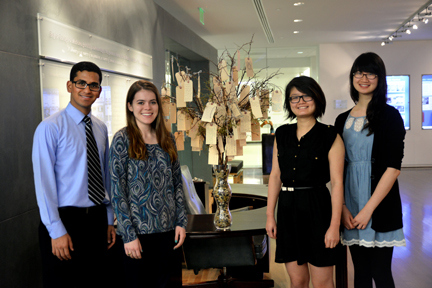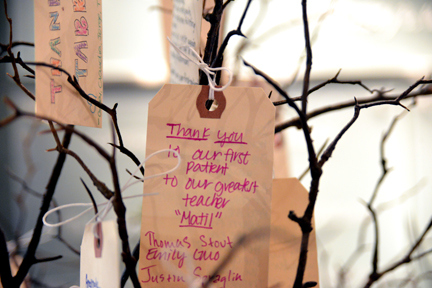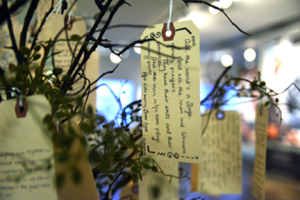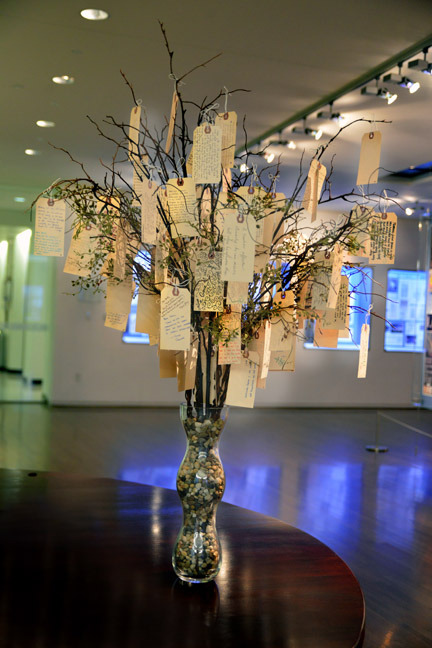'Silent professors' make impact
An important part of students’ medical education at Baylor College of Medicine comes through the anatomy lab, where they receive training during their first months as students. They learn from their instructors, through peer-to-peer learning and, perhaps most importantly, through their “silent professors.”
These silent instructors are possible through the Willed Body Program at Baylor, which allows people to donate their bodies after death to science so that students can train in human anatomy.
“In their silence, they have taught our students so much,” said Dr. Frank Kretzer, director of anatomical sciences at Baylor. “We are so grateful for these people who decided to donate their bodies to science and for the impact they have had on our future health care professionals.”
Medical and allied health students recently honored those who made the ultimate contribution to the study of science at a ceremony held March 13. At the ceremony, students honored these donors through personal reflections. As a memorial to the donors, they created a tree representing life on which hangs written reflections from students. It will be permanently housed in the Haley Museum in the DeBakey Building. The museum houses specimens and other items related to Baylor’s anatomy program, and is named after the first anatomy professor in Houston, Dr. John Haley.
The following first-year medical students served on the planning committee for the Donor Honor Ceremony. They gave their thoughts on the impact of the Willed Body Program.
Dana Larsen
“Being able to learn anatomy from a willed body, specifically for the purpose of educating future physicians, is truly a unique and privileged opportunity that I received at Baylor College of Medicine that I am so thankful for. Never again will I get such an experience to learn the intricacies of the human body. But more than that, my experience in the lab was really my first moment of ‘awe’ in medicine. Part of the reason I chose to enter the field of medicine was for those senses of awe you get to experience on a day-to-day basis … at a patient-to-patient level. This donor was in a unique way my very first patient and, as such, instilled in me a sense of awe for what we know and learn and are able to treat in medicine. It left me astounded as to the vast array of processes the body is capable of performing, the intricate precision of details that are required for proper functioning, and how unique each and every one of us are in performing these similar functions. While the course progressed and some of that initial awe was lost to frustration of memorizing terms and finding specific structures, the ever presence of the donor, who voluntarily offered to teach us in a way no one else could, always reminded me of the greater goals I had for myself in the medical field.”
Lakshay Jain
“For me personally, I think the willed body program is an extremely necessary component of medical school training, and apart from the understanding of anatomy that can be gleaned from direct observation of the human body, one of the most important lessons it teaches us is how to come to terms with our emotions and with death in general. Anatomy lab has been, without a doubt, one of the most influential parts of my medical training, and one I doubt I will ever forget. Through working with our donor bodies, all of us first-year medical students have learned so much, not just about the human body but about ourselves as well.”
Rui Zheng
“I think our class can agree that anatomy lab was a trial by fire – you learn about yourself as well as the human body. Certain labs were particularly surreal as you find something that personalizes the donors – painted nails, leftover prosthetic devices, sutures from past procedures, and the inescapable evidence of diseases that ravaged their bodies, visible even after death. Our project ended up being the physical accumulation of everyone’s experiences: a tree that symbolically represents the roots of our medical education and the growth we have experienced and will continue to experience as we continue forward. As someone who worked on accumulating the tags with everyone’s thoughts and wishes, I can whole-heartedly say that the overwhelming response was one of gratitude for donors who gave us the opportunity to intimately explore the human body, garner expertise through mistakes, and learn the fragility of life. Without the donors, we would not be able to appreciate how the body works and how easily it can be broken.”
–This story originally appeared in the April 2014 issue of BCM Family.









Pingback: Wing of Zock “Chart Review” Blog Carnival: May 2014 Edition | Wing Of Zock